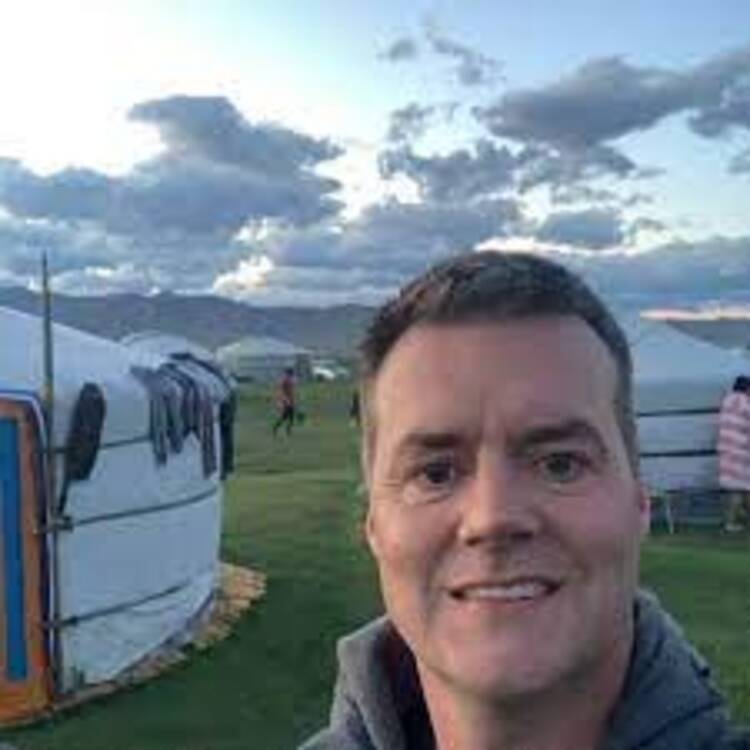The end of a long journey back to my new home.
At the end of my time in Khovd, things looked good. The car had been repaired, and we had readied all that we needed for the journey home. There was still the odd noise coming from the Kluger, but we were told not to worry as it was 20 years old.
We prepared fruit from local farmers and sellers to take back to the city, and just like that, we were ready to go. After sleeping, it was time to say goodbye to everyone. I was surprised that when I left, local friends and family gave me some money putting it either into my pocket or into my hand. It was quite a lovely tradition and one I hope to come across again in the future.
We had planned the journey as when travelling to Khovd; there are three routes the North (the most adventurous and mostly off-road, The middle (the route we had taken, challenging but pleasant), and the south (paved most of the way skirting the Gobi desert and the easiest route.)
I had opted for the southern route as I still lacked Mongolian driving experience, and to be honest, part of me just wanted to return to Ulaanbaatar. We could find no convoys travelling in the same direction, so it was decided a friend would join us to help with the long drive, which would take two days.
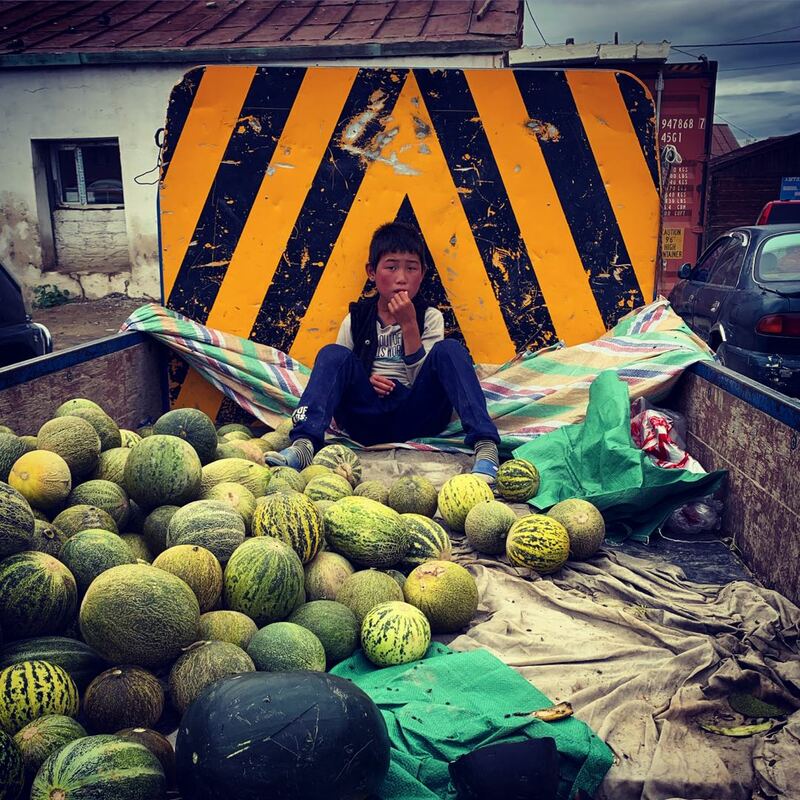
Time To Go (well, almost!)
In Mongolia, time is not an exact science, and my plan to leave Hovd at 6 am rapidly turned into 9 am. Once I had eaten the large breakfast offered and worked my way through the many goodbyes and friends checked my loading of the car, I was eventually ready to go.
We drove through the town to pick up a Temujin, a man who would be my back driver. Unfortunately, he had been out with friends the night before and was a little worse for wear as soon as I saw him; I realised I would be driving solo today!
After refuelling on the outskirts of Khovd, we were off; I felt rather sad as we climbed the steady hill heading south. I stopped briefly to look back; I could see the water meadows dotted with tiny white Gers surrounding Khovd while the mountains in the distance framed the image.
The car hummed perfectly along the slither of tarmac cutting through the arid landscape; I switched on the stereo; the Mongolian throat singing was almost as loud as Temujin snoring in the back.
Many locals had told me the scenery wasn't that good on the southern route, although I had never travelled this way and was still quite impressed by what I saw. Large areas of the steppe reached out to mountains in the far distance, and clouds formed a patchwork of shadows indispersed by the bright summer sun. Occasionally the clouds would darken, and rain would fall like icy vertices hammering on the windshield.
I made sure to make regular stops for food as well as never to pass a petrol station. In some areas, we wouldn't see a car for 30- 40 mins, and the road just kept going as straight as a dye; what could go wrong!
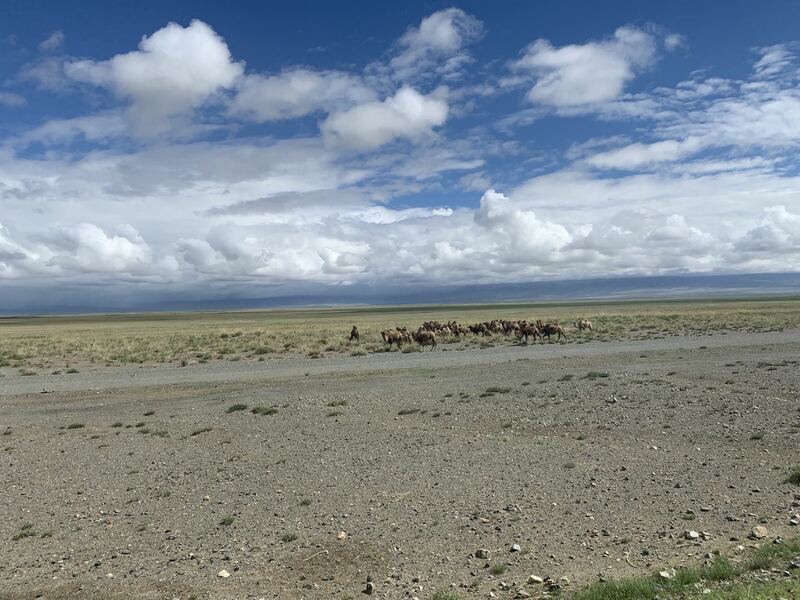
Trouble on the Horizon
I had my Mongolian driving license, of which I am very proud; I had read the rules on speed limits of which I was clear, but I had also made the mistake of listening to the family!
Now the speed limit in the countryside is 80KM per hour, but someone who shall not be named told me that there is no actual limit when in remote areas. The new tarmac roads in the countryside are such that around 120 km can be reached safely, and even then, most locals will tear past.
As I approached the small village of Bulgan, I was making excellent time and hoped to break the back of the journey today. Then the first issue, as I passed the crest of a small hill in the distance, I saw the tell-tell sign of police fluorescent jackets, as I got closer, and they motioned me to stop.
They asked me how fast I was going, which I was puzzled by as they were the ones with the speed camera. I decided to be honest and told them I was doing 120 but slowed to 100 KM for the hill! They looked at me, surprised, and asked me if I had studied the highway code as the limit was only 80 KM per hour.
All I could do was apologise, my license was taken, and we were left sat waiting. From the rear, Temujin, who had awoken, crossed the road and began chatting to the officers. Around this time, my three-year-old daughter awoke and began to cry very loudly; whilst my son asked if I was going to prison, I sat there, wanting to disappear.
In amongst all of this commotion, I think the police could tell I was being honest and eventually allowed to leave with a warning; I drove off at a much safer legal speed, feeling a little red-faced and embarrassed.
Another Hiccup
After being stopped, we drove on, deciding to rest at the town of Altai, a place I had wanted to have a little explore of for some time. Finding a small convenience store, we got out to stretch our legs. I looked around the car and decided to have a check underneath; then, I noticed we had a possible issue. The two rear tyres which had been replaced in Kovd were showing signs of wear!
It was a worry as we had only travelled 550 Km and still had well over 1000 KM to go. I checked the tyres, and although they were wearing, they were still within safe limits. We had little choice but to continue; instead of stopping for some exploration, we continued.
On the outskirts of Altai, we passed some interesting Soviet military basses, some semi-abandoned and some in use. As we continued, we hit a pothole and bump; it felt like the road we were on hand not seen a repair since the Soviet Union. In the back, the kids were having a great time whilst Temujin appeared to turn a light shade of green.
Up ahead, the road would worsen as there was a section that was still to be paved I had been told that it was around 20-40 KM and not to difficult. We made one more stop tour pour a coffee, and check the tyres; unfortunately, the situation was worse, then we had thought. The two rear tyres had gone from being ok to now bald. The offside rear tyre looked bad, and we thought it might blow at any moment. We used the spare but were now worried, as the near side rear at the rate we were going may also blow, especially as the tarmac was running out.
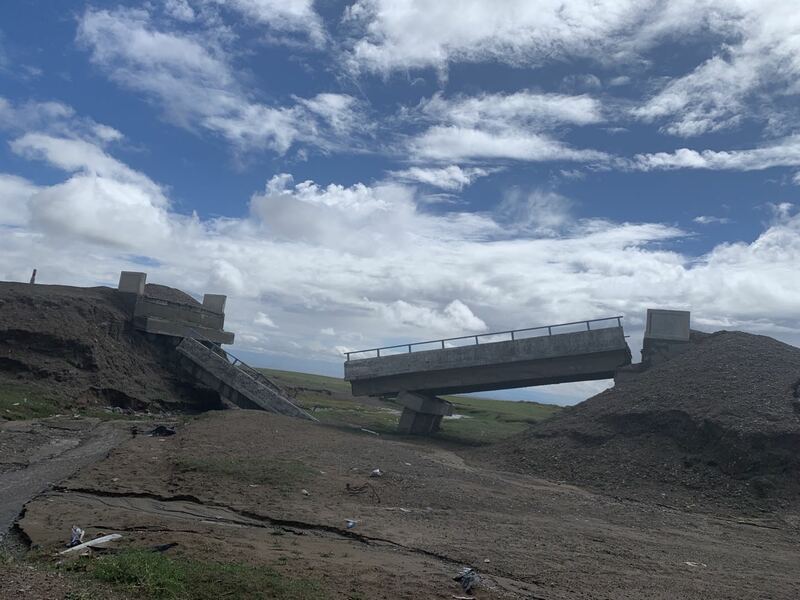
Beyond Thunder Dome!
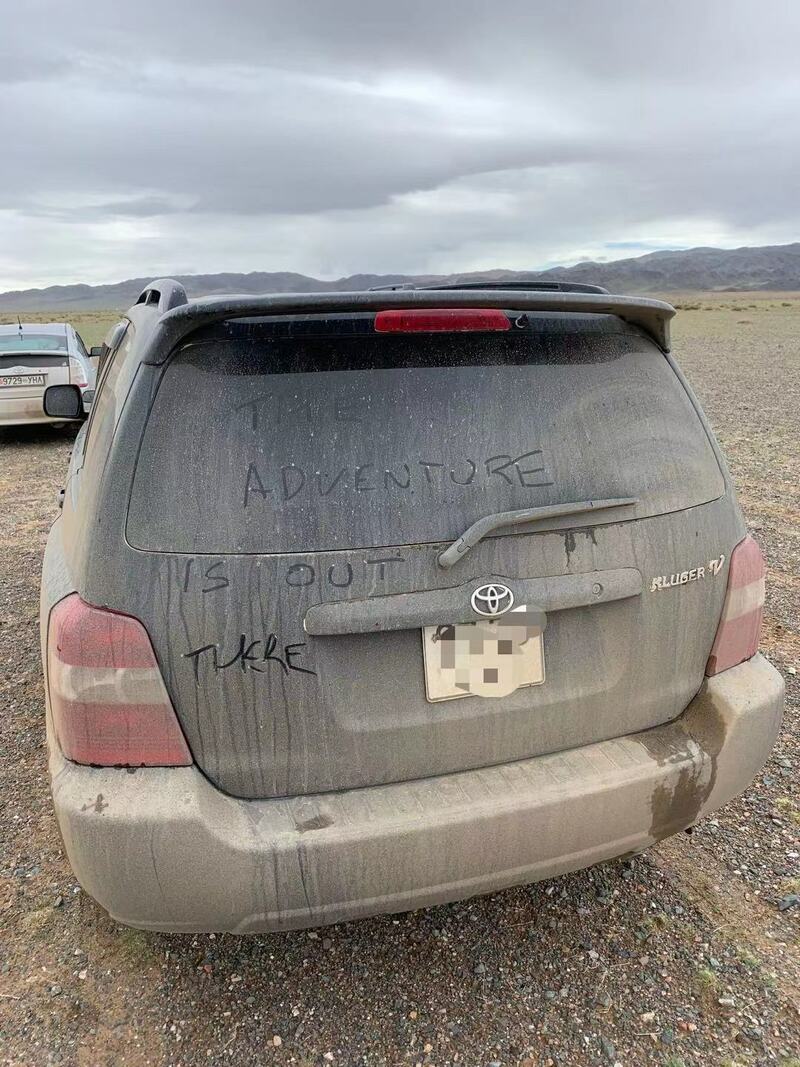
Now I am not sure what people before me were talking about, but the simple offroad section described was certainly not the one we now found ourselves travelling along. The only way I can describe it is like something from a mad max movie. The trail was made up of mud and sand with no defined route. Cars, trucks and even busses bombed past, filling the air with dust. On top of that, the sand terrain occasionally gave way to rocks and stones. As we rocked and juddered along, the car would shack violently. I wasn't sure if I wanted to laugh or cry. If the vehicle had been in a good state of repair, I might well have felt differently.
The whole situation was made even scarier as construction trucks and bulldozers would appear out of the dust, cutting across the trail. As the route worsened, our speed was down to only a few KM per hour. Where we could, we would stop to check the tyres, which were now showing the radials. After two hours of driving, we eventually made it to a new road and pulled into the town of Bayankhongor well into the night. Not as far as we had hoped to be, but at least we were safe.
In, Buutsagaan our first stop was to try and get a local dinner, but we were informed that there was a power cut, the town did seem a little dark. After drinking some Mongolian tea, we were given some slightly better news that right next door was a tyre repair shop and next door to them a roadside Ger camp (Mongolian motel).
Eventually, the tyre guy arrived summoned from the town; he did look shocked as he replaced our two rear shinny tyres. He explained that he just replaced tyres and didn't know what the cause of our problem was. Once we had loaded up another spare, we headed to the ger for an attempt at sleep.
It was a troubled night wondering if I'd get the car back to its owner or it would be destined to stay out here in the Mongolian wilds, the true home of the 4X4.
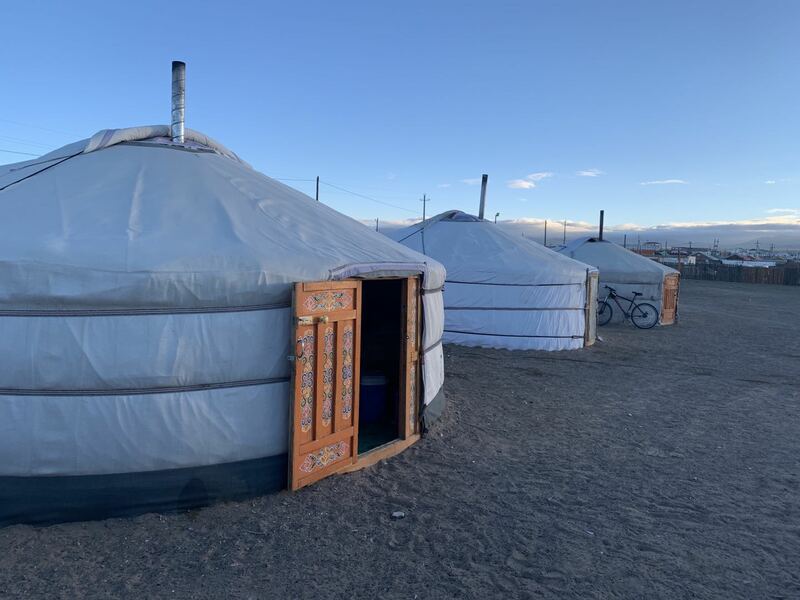
Another Day!
We left early, keen to get going; it was a bit of a shame as the journey was beautiful and I would have liked the time to stop and photograph some of the route. We passed rocky escarpments twisting river valleys and small remote rural towns. In the own of Bayankhongor, we met a friend who tried to help us find a garage that may help, but unfortunately, we were told it might take a day or two as any parts require would have to come from the Ulaanbaatar.
Our friend helped us load any none essential luggage onto a latter bus that would arrive in Ulaanbaatar the following day; we did this, hoping that it would lighten the load.
Once on the road again, we passed a convoy of enormous mining trucks; I couldn't help wonder what it would be like to change a tyre on one of them. As we pulled on past, our car worked out about half of their tyres' size, and I have to say I gripped the steering wheel a little tighter as I passed.
I would stop every hour Temujin, and I would walk around the back of the car climb on all fours, looking at the tyres, change places, assess the wear and kind of nod both knowing the situation wasn't perfect, but at least we had enough treed to go another hour.
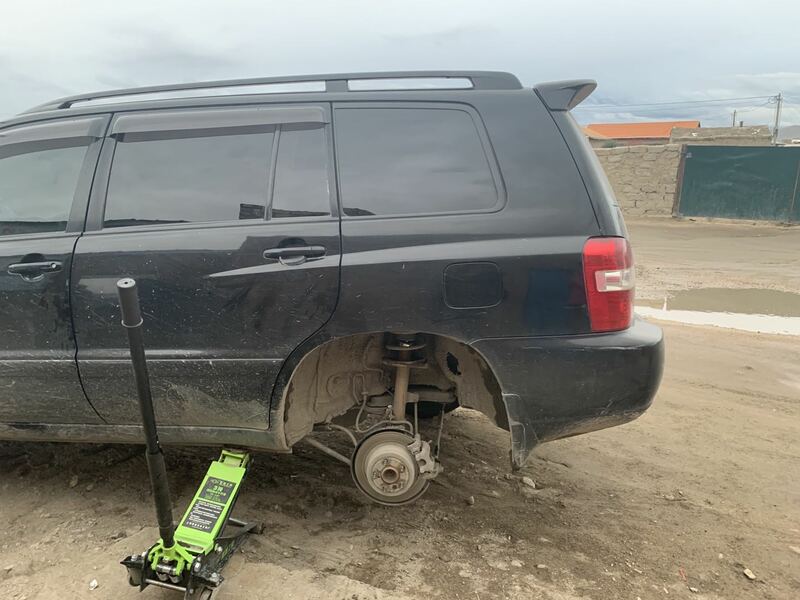
The Homeward Straight
A moment of reassurance came when we reached Elsen Tasarkhai, as this is the road we took out of Ulaanbaatar. Although my relief was short-lived as darkness closed in around us, driving on Mongolian roads at night isn't ideal as harsh conditions become even worse.
Many drivers turn their headlights on full beam, and most cars have heavily tinted windows causing visibility to be even lower. I hated every minute of this part of the adventure but eventually reached Ulaanbaatar's outskirts at around 2 am.
One More Stop
I was looking forward to heading home just as we received a call from the coach driver who was helping us with our luggage. He informed us that he was now only one hour behind. So we diverted to the Dragon bus terminal, waited and reloaded and drove into the capital.
After dropping Temujin at his home, we eventually rolled into our apartment car park; the time was around 6 am, just as the sun rose. Over 1500 kilometres, 33 hours and our summer adventure had finished. I had a cup of tea and peered out of the window at the car below, which sat amongst an assortment of Toyota Prius's and various 4x4s. I drew the curtains and went to sleep; tonight would be the first night I had slept in two months without being just a few metres from the car.
If you were wondering, before I returned the car, I had it fixed and was informed by the car doctor that whoever had repaired the original damage in Khovd hadn't realigned the wheels, which is why the tyres were wearing.
